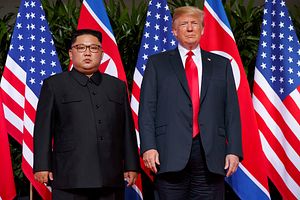The joint statement signed after the historic U.S.-DPRK summit on June 12 appears to be a half-baked document lacking any kind of substance. Although working talks between the two nations extended well into the night of the day before the summit, a grand, all-encompassing, resolution of the century failed to materialize. Very likely, the rush to hold the summit – which came just three months after U.S. President Donald J. Trump signaled his willingness to meet with Chairman Kim Jong-un – ruled out the possibility of any substantive breakthrough.
The wording of the agreement on the primary focus of denuclearization was limited to “complete denuclearization of the Korean Peninsula,” stopping short of the “complete, verifiable and irreversible” denuclearization (“CVID”) the U.S. was seeking. Even so, Trump announced his intention to halt joint military exercises between the U.S. and South Korea. While this looks as though North Korea won a concession from the U.S. side, the actual benefit to the North Koreans is debatable. If the North does not work seriously towards denuclearization, nothing will change in a structural sense, since diplomatic ties with the U.S. will not be normalized, nor will any sanctions be lifted. Moreover, without a specific agreement on a time schedule, the U.S. side also has room for interpretation. This is hardly ideal for North Korea either.
If North Korea only wishes to prevent a U.S. military strike, continuing top-level talks between China and South Korea would suffice. And if the North had continued with the nuclear weapon and missile tests of last year, even the ultra-hardline administration of the United States would have had had little recourse given the risk of human casualties in Japan and South Korea. If this latest agreement is the only outcome, it is hard to explain why North Korea went to such lengths to hold the summit.
The idea of engaging in talks in a third country with the head of “U.S. imperialism” that the North has long reviled and criticized is one that is fraught with risk for Kim Jong-un. While Kim currently has confidence in his grasp on power, including his control over the military, no one can predict what a sudden about-face towards historic peace with a long-standing enemy might bring. In that context, it was surprising that, even though Singapore went all out to provide security, there were still a large number of regular guests at the hotel where Kim was staying. From North Korea’s perspective, that would seem impossibly lax.
Developing a nuclear arsenal is hugely time consuming and expensive, and as such, no nuclear power is going to relinquish that status lightly. However, if North Korea is offered by the United States benefits that match or exceed its outlays, it might conceivably be prepared to give up its nuclear ambitions. North Korea possesses nuclear weapons in order to give them up at the perfect time. After all, being a nuclear power does carry its own costs for North Korea, among them a higher threat of an attack by the United States and stiffer economic sanctions. Looking several decades ahead, the 34-year-old Kim Jong-un embarked on negotiations with the United States with an eye to regime survival. In the latest media reports from North Korea, there has been a notable emphasis on socialism and non-interference in internal affairs, along with support for preventing the “encroachment of imperialistic philosophy.” Accordingly, Kim opted for negotiations and the associated risks to preserve his regime. In this way, Kim has sought to alter North Korea’s survival strategy. Given its limited interest in human rights issues compared with previous administrations, the Trump administration and its penchant for “big deals” do indeed represent a unique opportunity.
Even if North Korea does intend to abandon nuclear weapons down the road, a host of difficulties will arise when it comes to translating the “complete denuclearization” agreement into action. North Korean officials are extremely conservative, and this will likely lead to disagreements during the inspection stage. For this reason, it will be important to watch and see whether Kim will listen to feedback from the Political Bureau and Central Committee of the Workers’ Party of Korea, and thoroughly instill in North Korea the idea that this latest move towards peace is irreversible. In North Korea, meetings are not forums to decide on items by majority decision; rather, they are an opportunity for the leader to convey policies to subordinates.
Considering developments over the past seven decades, last week’s summit was an unprecedented step forward. The Rodong Shinmun, the newspaper of the Workers’ Party of Korea, reported that the talks “ended a relationship of extreme hostility,” and mentioned that Kim Jong-un would take “practical measures at an early opportunity.” In fact, the White House deserve high marks for agreeing to meet North Korea halfway in finding realistic measures towards denuclearization, as typified by the agreement to “abide by the principle of step-by-step and simultaneous action.”
Somewhat surprisingly, reporting on the summit in North Korea has not been limited to simple praise of the accomplishments of Chairman Kim Jong-un. North Korea media openly reported on Kim’s use of Chinese-operated aircraft for the return trip to Singapore, and glimpses of the pragmatic aspects of the Kim Jong-un regime abounded. The text of the agreement and exchanges between the two leaders were the same as those released by the U.S., and the state media ran with several images depicting a beaming Kim engaging with Trump. North Korea also sees this “historic peace” as something that is irreversible. Perhaps the vague wording of the agreement is in preparation for a more substantive agreement to be forged between both sides. To that end, while the United States continues to focus on complete, verifiable, irreversible denuclearization, it would do well to continually paint a bright future for North Korea.
Atsuhito Isozaki is an Associate Professor at Keio University.

































